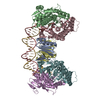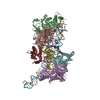[English] 日本語
 Yorodumi
Yorodumi- PDB-8fyc: Cryo-EM structure of Cas1:Cas2-DEDDh:half-site integration comple... -
+ Open data
Open data
- Basic information
Basic information
| Entry | Database: PDB / ID: 8fyc | ||||||||||||
|---|---|---|---|---|---|---|---|---|---|---|---|---|---|
| Title | Cryo-EM structure of Cas1:Cas2-DEDDh:half-site integration complex linear CRISPR repeat conformation | ||||||||||||
 Components Components |
| ||||||||||||
 Keywords Keywords | DNA BINDING PROTEIN/DNA / CRISPR / integrase / CRISPR adaptation module / PAM / prespacer / exonuclease / DNA binding protein-DNA complex / enzyme / ribonucleoprotein | ||||||||||||
| Function / homology | DNA / DNA (> 10) Function and homology information Function and homology information | ||||||||||||
| Biological species |  Megasphaera (bacteria) Megasphaera (bacteria) | ||||||||||||
| Method | ELECTRON MICROSCOPY / single particle reconstruction / cryo EM / Resolution: 4.1 Å | ||||||||||||
 Authors Authors | Skopintsev, P. / Tuck, O.T. / Soczek, K.M. / Doudna, J. | ||||||||||||
| Funding support |  United States, United States,  Switzerland, 3items Switzerland, 3items
| ||||||||||||
 Citation Citation |  Journal: Nature / Year: 2023 Journal: Nature / Year: 2023Title: Genome expansion by a CRISPR trimmer-integrase. Authors: Joy Y Wang / Owen T Tuck / Petr Skopintsev / Katarzyna M Soczek / Gary Li / Basem Al-Shayeb / Julia Zhou / Jennifer A Doudna /  Abstract: CRISPR-Cas adaptive immune systems capture DNA fragments from invading mobile genetic elements and integrate them into the host genome to provide a template for RNA-guided immunity. CRISPR systems ...CRISPR-Cas adaptive immune systems capture DNA fragments from invading mobile genetic elements and integrate them into the host genome to provide a template for RNA-guided immunity. CRISPR systems maintain genome integrity and avoid autoimmunity by distinguishing between self and non-self, a process for which the CRISPR/Cas1-Cas2 integrase is necessary but not sufficient. In some microorganisms, the Cas4 endonuclease assists CRISPR adaptation, but many CRISPR-Cas systems lack Cas4. Here we show here that an elegant alternative pathway in a type I-E system uses an internal DnaQ-like exonuclease (DEDDh) to select and process DNA for integration using the protospacer adjacent motif (PAM). The natural Cas1-Cas2/exonuclease fusion (trimmer-integrase) catalyses coordinated DNA capture, trimming and integration. Five cryo-electron microscopy structures of the CRISPR trimmer-integrase, visualized both before and during DNA integration, show how asymmetric processing generates size-defined, PAM-containing substrates. Before genome integration, the PAM sequence is released by Cas1 and cleaved by the exonuclease, marking inserted DNA as self and preventing aberrant CRISPR targeting of the host. Together, these data support a model in which CRISPR systems lacking Cas4 use fused or recruited exonucleases for faithful acquisition of new CRISPR immune sequences. | ||||||||||||
| History |
|
- Structure visualization
Structure visualization
| Structure viewer | Molecule:  Molmil Molmil Jmol/JSmol Jmol/JSmol |
|---|
- Downloads & links
Downloads & links
- Download
Download
| PDBx/mmCIF format |  8fyc.cif.gz 8fyc.cif.gz | 331.3 KB | Display |  PDBx/mmCIF format PDBx/mmCIF format |
|---|---|---|---|---|
| PDB format |  pdb8fyc.ent.gz pdb8fyc.ent.gz | 262.6 KB | Display |  PDB format PDB format |
| PDBx/mmJSON format |  8fyc.json.gz 8fyc.json.gz | Tree view |  PDBx/mmJSON format PDBx/mmJSON format | |
| Others |  Other downloads Other downloads |
-Validation report
| Summary document |  8fyc_validation.pdf.gz 8fyc_validation.pdf.gz | 1.2 MB | Display |  wwPDB validaton report wwPDB validaton report |
|---|---|---|---|---|
| Full document |  8fyc_full_validation.pdf.gz 8fyc_full_validation.pdf.gz | 1.3 MB | Display | |
| Data in XML |  8fyc_validation.xml.gz 8fyc_validation.xml.gz | 57.7 KB | Display | |
| Data in CIF |  8fyc_validation.cif.gz 8fyc_validation.cif.gz | 87.6 KB | Display | |
| Arichive directory |  https://data.pdbj.org/pub/pdb/validation_reports/fy/8fyc https://data.pdbj.org/pub/pdb/validation_reports/fy/8fyc ftp://data.pdbj.org/pub/pdb/validation_reports/fy/8fyc ftp://data.pdbj.org/pub/pdb/validation_reports/fy/8fyc | HTTPS FTP |
-Related structure data
| Related structure data |  29564MC  8fy9C  8fyaC  8fybC  8fydC C: citing same article ( M: map data used to model this data |
|---|---|
| Similar structure data | Similarity search - Function & homology  F&H Search F&H Search |
- Links
Links
- Assembly
Assembly
| Deposited unit | 
|
|---|---|
| 1 |
|
- Components
Components
-Protein , 3 types, 7 molecules KDABCEF
| #1: Protein | Mass: 18652.561 Da / Num. of mol.: 1 Source method: isolated from a genetically manipulated source Source: (gene. exp.)  Megasphaera (bacteria) / Production host: Megasphaera (bacteria) / Production host:  | ||
|---|---|---|---|
| #3: Protein | Mass: 10661.198 Da / Num. of mol.: 2 Source method: isolated from a genetically manipulated source Source: (gene. exp.)  Megasphaera (bacteria) / Production host: Megasphaera (bacteria) / Production host:  #4: Protein | Mass: 34534.512 Da / Num. of mol.: 4 Source method: isolated from a genetically manipulated source Source: (gene. exp.)  Megasphaera (bacteria) / Production host: Megasphaera (bacteria) / Production host:  |
-DNA chain , 4 types, 4 molecules JGHI
| #2: DNA chain | Mass: 23953.268 Da / Num. of mol.: 1 / Source method: obtained synthetically / Source: (synth.)  Megasphaera (bacteria) Megasphaera (bacteria) |
|---|---|
| #5: DNA chain | Mass: 17569.213 Da / Num. of mol.: 1 / Source method: obtained synthetically / Source: (synth.)  Megasphaera (bacteria) Megasphaera (bacteria) |
| #6: DNA chain | Mass: 9528.133 Da / Num. of mol.: 1 / Source method: obtained synthetically / Source: (synth.)  Megasphaera (bacteria) Megasphaera (bacteria) |
| #7: DNA chain | Mass: 13655.844 Da / Num. of mol.: 1 / Source method: obtained synthetically / Source: (synth.)  Megasphaera (bacteria) Megasphaera (bacteria) |
-Experimental details
-Experiment
| Experiment | Method: ELECTRON MICROSCOPY |
|---|---|
| EM experiment | Aggregation state: PARTICLE / 3D reconstruction method: single particle reconstruction |
- Sample preparation
Sample preparation
| Component | Name: Cas1:Cas2-DEDDh:half-site integration complex / Type: COMPLEX / Entity ID: all / Source: MULTIPLE SOURCES |
|---|---|
| Molecular weight | Value: 0.272 MDa / Experimental value: NO |
| Source (natural) | Organism:  Megasphaera (bacteria) Megasphaera (bacteria) |
| Source (recombinant) | Organism:  |
| Buffer solution | pH: 7.5 |
| Specimen | Embedding applied: NO / Shadowing applied: NO / Staining applied: NO / Vitrification applied: YES |
| Specimen support | Grid material: GOLD / Grid mesh size: 300 divisions/in. / Grid type: Quantifoil R1.2/1.3 |
| Vitrification | Instrument: FEI VITROBOT MARK IV / Cryogen name: ETHANE / Humidity: 100 % / Chamber temperature: 281 K |
- Electron microscopy imaging
Electron microscopy imaging
| Experimental equipment |  Model: Talos Arctica / Image courtesy: FEI Company |
|---|---|
| Microscopy | Model: FEI TALOS ARCTICA |
| Electron gun | Electron source:  FIELD EMISSION GUN / Accelerating voltage: 200 kV / Illumination mode: OTHER FIELD EMISSION GUN / Accelerating voltage: 200 kV / Illumination mode: OTHER |
| Electron lens | Mode: BRIGHT FIELD / Nominal defocus max: 2200 nm / Nominal defocus min: 800 nm / Alignment procedure: COMA FREE |
| Specimen holder | Cryogen: NITROGEN |
| Image recording | Electron dose: 50 e/Å2 / Film or detector model: GATAN K3 (6k x 4k) |
- Processing
Processing
| Software | Name: PHENIX / Version: 1.20.1_4487: / Classification: refinement | ||||||||||||||||||||||||||||||||||||||||
|---|---|---|---|---|---|---|---|---|---|---|---|---|---|---|---|---|---|---|---|---|---|---|---|---|---|---|---|---|---|---|---|---|---|---|---|---|---|---|---|---|---|
| EM software |
| ||||||||||||||||||||||||||||||||||||||||
| CTF correction | Type: PHASE FLIPPING AND AMPLITUDE CORRECTION | ||||||||||||||||||||||||||||||||||||||||
| 3D reconstruction | Resolution: 4.1 Å / Resolution method: FSC 0.143 CUT-OFF / Num. of particles: 58475 / Symmetry type: POINT | ||||||||||||||||||||||||||||||||||||||||
| Atomic model building | Protocol: OTHER / Space: REAL | ||||||||||||||||||||||||||||||||||||||||
| Refine LS restraints |
|
 Movie
Movie Controller
Controller






 PDBj
PDBj






































